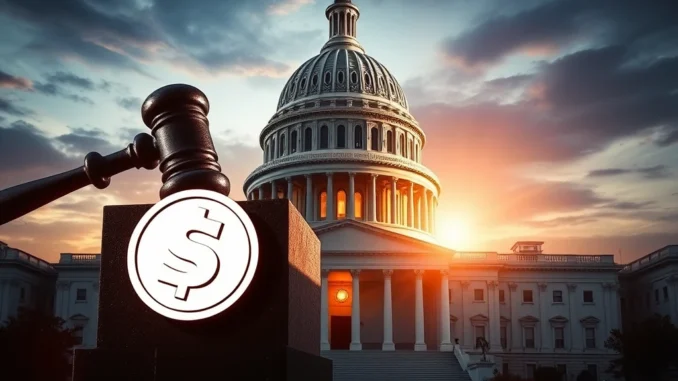
The world of cryptocurrency is buzzing as the U.S. House Financial Services Committee has officially commenced discussions on stablecoins. This pivotal move signals a potential turning point for the crypto industry in the United States, sparking both excitement and anticipation. Are we on the verge of groundbreaking crypto regulation? Let’s dive into what this means for you and the future of digital currencies.
Why are Stablecoin Discussions by the US House Financial Services Committee Crucial?
The US House Financial Services Committee‘s decision to prioritize stablecoin discussions underscores the growing significance of these digital assets within the broader financial landscape. But why now? Here’s a breakdown of the key reasons this development is grabbing headlines:
- Rapid Growth of Stablecoins: Stablecoins, cryptocurrencies pegged to a stable reserve asset like the US dollar, have seen explosive growth. Their stability makes them attractive for everyday transactions and as a safe haven within the volatile crypto market. This surge in popularity has naturally caught the attention of regulators.
- Financial Stability Concerns: With increasing adoption comes increased scrutiny. Regulators are keen to ensure that stablecoins don’t pose risks to financial stability. Concerns range from reserve management and transparency to potential impacts on monetary policy.
- Consumer Protection Imperative: Protecting consumers is paramount. The committee is likely examining how to safeguard users of digital wallets and payment apps that utilize stablecoins, ensuring fair practices and mitigating risks of fraud or loss.
- Presidential Push for Legislation: Former President Trump’s public statement urging for stablecoin legislation before the August recess adds significant weight and urgency to these discussions. This political momentum suggests a real intent to move forward with regulation.
What Bills are on the Table for Crypto Regulation?
The US House Financial Services Committee isn’t starting from scratch. Several key legislative proposals are already in the mix, shaping the direction of these crucial discussions. Let’s take a closer look at some of the bills being considered:
- Rep. Tom Emmer’s CBDC Issuance Restriction Law: This proposed law focuses on limiting the issuance of a Central Bank Digital Currency (CBDC). It reflects concerns about government overreach and the potential impact of a CBDC on privacy and the existing financial system. The discussion around this bill highlights the tension between innovation and control in the digital currency space.
- CFPB Regulations Targeting Tech Companies: The Consumer Financial Protection Bureau (CFPB) is reportedly looking at regulations specifically targeting technology companies involved in payment apps and digital wallets. This could bring increased oversight to how these companies handle digital assets, including stablecoins, and interact with consumers. The aim is to ensure a level playing field and protect consumers using these platforms.
Stablecoins and CBDCs: Understanding the Difference
Often discussed together, stablecoins and CBDCs are distinct forms of digital currency. Understanding their differences is key to grasping the nuances of the current regulatory discussions.
| Feature | Stablecoins | CBDCs (Central Bank Digital Currencies) |
|---|---|---|
| Issuer | Private companies (e.g., Tether, Circle) | Central banks (e.g., Federal Reserve, European Central Bank) |
| Control | Decentralized (to varying degrees, depending on the stablecoin) | Centralized |
| Purpose | Facilitate crypto trading, payments, and DeFi applications; aim for price stability | Modernize payments, potentially improve financial inclusion, implement monetary policy |
| Regulation | Currently under development and varying across jurisdictions | Regulatory framework still largely under development |
The debate around crypto regulation often involves deciding how to categorize and regulate these different types of digital assets. The US House Financial Services Committee‘s discussions are crucial in shaping this regulatory landscape.
What are the Potential Benefits of Stablecoin Regulation?
While some in the crypto space may fear increased regulation, well-crafted rules for stablecoins could actually unlock significant benefits for the industry and users alike. Let’s explore some potential positives:
- Increased Legitimacy and Trust: Clear crypto regulation can bring legitimacy to the stablecoin market. This increased trust can attract more institutional and retail investors, fostering wider adoption.
- Enhanced Consumer Protection: Regulations focused on transparency, reserve requirements, and consumer safeguards can protect users from potential risks associated with stablecoins, such as stablecoin collapses or fraudulent schemes.
- Clarity for Businesses: Defined rules provide businesses operating with stablecoins with the clarity they need to innovate and grow within a compliant framework. This can encourage further development and adoption of stablecoin-based solutions.
- Integration with Traditional Finance: Regulation can pave the way for smoother integration of stablecoins into the traditional financial system, potentially leading to more efficient payment systems and innovative financial products.
Challenges and Considerations for Stablecoin Regulation
Navigating the complexities of stablecoin regulation is not without its challenges. The US House Financial Services Committee will need to grapple with several key considerations to ensure effective and balanced rules:
- Balancing Innovation and Regulation: The key challenge is to create crypto regulation that protects consumers and the financial system without stifling innovation in the rapidly evolving crypto space. Overly restrictive rules could push innovation overseas.
- Defining Regulatory Scope: Determining which entities and activities fall under stablecoin regulation is crucial. This includes defining what constitutes a stablecoin and how different types of stablecoins should be regulated.
- Interoperability and Global Coordination: Given the global nature of cryptocurrencies, international cooperation on stablecoin regulation is essential. Different regulatory approaches across jurisdictions could create confusion and arbitrage opportunities.
- Technological Complexity: Regulators need to understand the underlying technology of stablecoins and digital wallets to develop effective rules. This requires ongoing learning and adaptation to technological advancements.
Actionable Insights: What Does This Mean for You?
The US House Financial Services Committee‘s stablecoin discussions are a significant development with potential implications for everyone involved in the cryptocurrency ecosystem. Here’s what you should consider:
- Stay Informed: Keep a close eye on the progress of these discussions and any emerging crypto regulation. News outlets like Blockworks and industry publications will be crucial sources of information.
- Understand Stablecoins: If you are involved in crypto, deepen your understanding of stablecoins, their risks, and their potential benefits. This knowledge will be vital as the regulatory landscape evolves.
- Engage in the Conversation: Consider participating in online discussions and forums related to crypto regulation. Your voice and perspective are important as policymakers shape the future of digital currencies.
- Prepare for Change: The outcome of these discussions could lead to significant changes in how stablecoins and digital wallets operate. Be prepared to adapt to new regulations and compliance requirements.
Conclusion: The Future of Stablecoins and Crypto Regulation is Now
The US House Financial Services Committee‘s move to prioritize stablecoin discussions is a landmark moment for the cryptocurrency industry. As lawmakers grapple with the complexities of crypto regulation, the decisions made in the coming months will undoubtedly shape the trajectory of stablecoins and the broader digital asset space for years to come. This is a time of significant opportunity and potential transformation, demanding close attention and proactive engagement from everyone in the crypto community. The urgent debate has begun, and the future of finance is being written.



